AI Video Translation Explained: Tools, Tips and Step-by-Step Guide

As video content consumption rockets worldwide, the demand for multilingual support is rising just as fast. From product explainers and global marketing to entertainment, online courses, and training videos, video has become one of the most powerful format for communication. But without translation, its impact often stays limited.
Fortunately, AI has made video translation faster, more affordable, and scalable, making it accessible to teams and creators of all sizes. In this comprehensive guide you'll learn:
- What video translation is and its different types (dubbing, subtitles, etc.)
- How it works (AI vs. human vs. hybrid translation methods)
- The biggest benefits of using AI video translation
- Where it's having the most impact (by industry and platform)
- How to choose the right AI video translator for your goals
- A step-by-step walkthrough of translating a video with Maestra
- Best practices for quality, timing, and SEO
- Common challenges and how to overcome them
- FAQs to help you get started confidently
Let's get started.
What is video translation?
Video translation is the process of converting the spoken or written content within a video from one language to another, making it accessible to a global audience. It's an umbrella term encompassing various methods, each with its own purpose, benefits, and ideal use cases.
Types of Video Translation
Here are the most common types of video translation:
- Dubbing :Replaces the original dialogue with new, lip-synced audio in the target language. Commonly used in film, television, and entertainment to provide a fully localized experience.
- Voiceover: Adds a translated voice track over the original audio, which is usually lowered in volume. Often used in documentaries, interviews, and explainer videos.
- Subtitling: Displays translated text on screen while preserving the original audio. This method maintains the authenticity of the speaker’s voice and is widely used for YouTube videos, online courses, and global content.
- Closed captions with translation: Similar to subtitles, but also includes non-verbal elements like sound effects or speaker cues (e.g., [music playing], [laughter]). Useful for improving accessibility and meeting compliance requirements.
- Transcription + translation: Involves converting the speech to text in the source language and then translating it. Great for creating searchable archives, written summaries, or support materials.
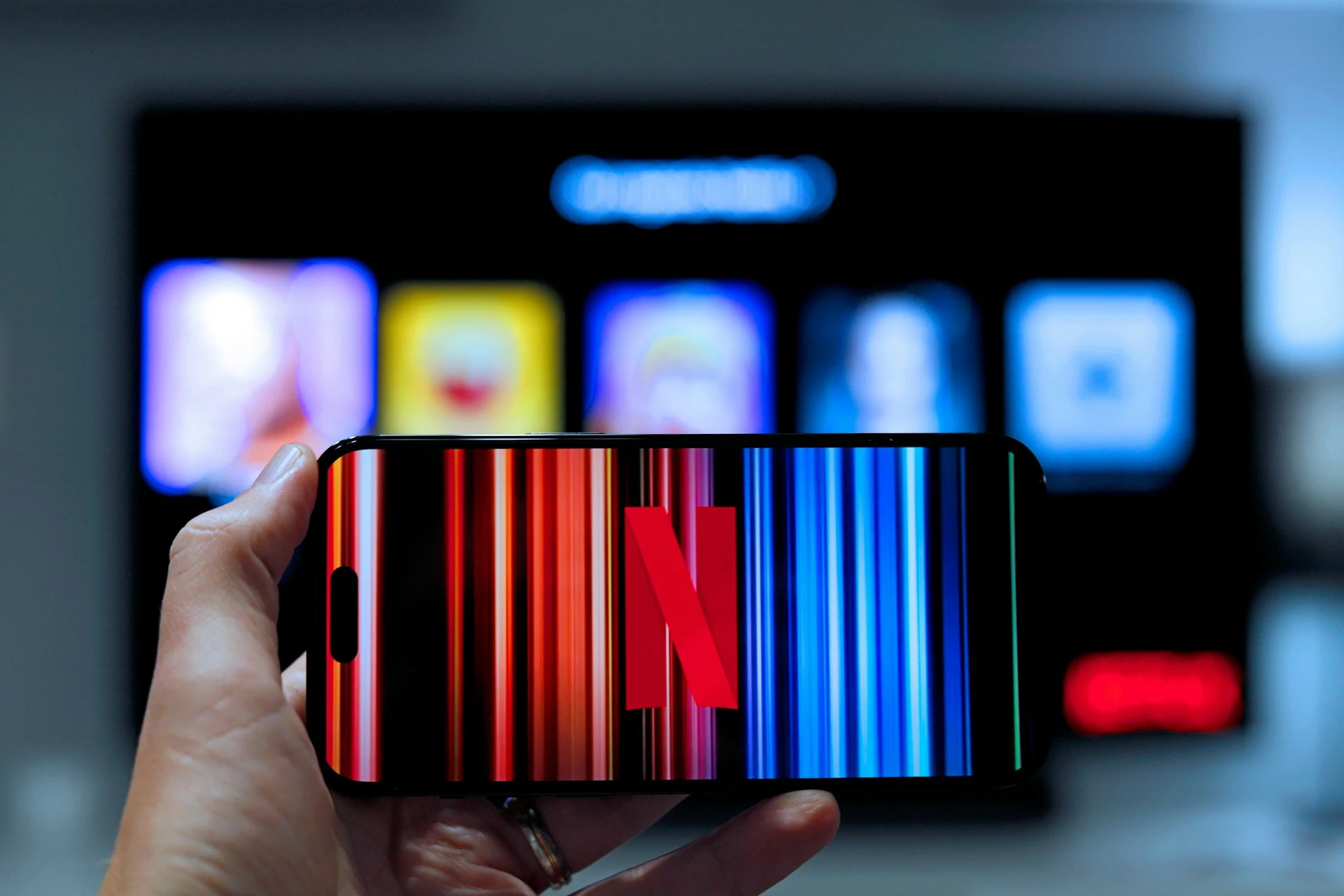
Methods of Video Translation
Video translation can be executed using different approaches including AI-powered translation, human translation, and hybrid translation.
AI Video Translation
AI video translation is the process of using artificial intelligence, typically powered by machine learning (ML) and natural language processing (NLP), to automatically translate the content of a video from one language to another. Tools like Maestra can handle everything from speech recognition and transcription to translation, subtitle generation, and voice synthesis.
An AI video translator can automatically detect spoken language, convert it into text, translate that text into the target language, and either display it as subtitles or generate a synthetic voice in the translated language.
Human Translation
Human video translation involves professional linguists manually translating a video's content. This ensures attention to tone and detail, but may be less practical for projects with tight deadlines or multiple language outputs.
Hybrid Translation
The hybrid method combines AI and human expertise. AI tools perform the initial transcription and translation, which are then reviewed, edited, or fine-tuned by a human translator.
| Method | Pros | Cons |
| AI Translation | -Fast, scalable, cost-effective
-Multilingual support |
-May lack nuance-Can misinterpret tone or slang |
| Human Translation | -Emotionally and culturally aware-Ideal for sensitive content | -Slower turnaround
-Higher cost |
| Hybrid Translation | -Human oversight-More affordable than full human translation | -Still requires manual review-Depends on AI output quality |

Choosing the right method depends on your content goals, timeline, and budget. In the next section, we'll explore the key benefits of AI video translation, and why it's becoming a go-to solution for content creators, educators, and businesses alike.
Top Benefits of Video Translation
Whether you're localizing videos for global audiences or optimizing internal training materials, AI-powered tools offer a smart way to break language barriers and reach more viewers without compromising quality.
Here are the key benefits:
Speed and Efficiency
Traditional translation workflows can take days or weeks. AI video translators dramatically reduce turnaround times by automating transcription, translation, subtitling, voice dubbing, and even voice cloning in minutes.
Why it matters: Great for fast-paced content pipelines such as social media, e-learning updates, or breaking news.
Global Reach at Scale
AI tools support dozens of languages simultaneously, making it easy to localize content for global markets in one go.
Why it matters: You can reach multilingual audiences without needing a separate team of translators for each language. For instance, Maestra's AI video translator supports over 125 languages, allowing users to distribute their content worldwide with just a few clicks.
Cost-Effectiveness
Compared to manual workflows, AI video translation significantly reduces operational costs, especially for high-volume content or smaller teams with limited resources.
Why it matters: More accessible for startups, educators, nonprofits, and creators who need professional results on a budget.
SEO and Discoverability
When videos are translated and subtitled in multiple languages, they become more discoverable across regions, search engines, and video platforms.
Why it matters: Boosts organic traffic, video watch time, and keyword reach, especially when targeting international audiences.

Engagement and Retention
When users can consume video content in their native language, they’re more likely to stay engaged, understand the message, and take action.
Why it matters: Increases watch duration, reduces bounce rates, and improves learning outcomes in training or educational videos.
Accessibility and Inclusion
AI video translation tools often support features like closed captions and speaker labeling, making content more accessible to people who are deaf, hard of hearing, or non-native speakers.
Why it matters: Promotes inclusive communication and helps meet accessibility standards across education, enterprise, and media.
Credibility and Trust
Providing content in a user's native language demonstrates a commitment to their needs and cultural understanding, building and fostering trust.
Why it matters: Elevates your brand's reputation as globally-minded and customer-centric, leading to stronger relationships and loyalty.
High-Impact Use Cases for Video Translation
Video translation is no longer a niche service; it's a strategic imperative across diverse industries. Below are some of the most impactful use cases:
Media, Film & Entertainment
TV shows, short films, YouTube videos, and podcasts can be dubbed or subtitled to serve audiences in multiple regions, expanding viewership and monetization.
Who benefits: Content creators, studios, streaming platforms, influencers.
E-Learning and Online Education
Courses, lectures, tutorials, and training videos can be translated to support learners around the world. Subtitles and voiceovers in native languages improve comprehension and knowledge retention.
Who benefits: EdTech platforms, universities, online instructors, corporate L&D teams.

Marketing & Brand Content
Translating product videos, ads, testimonials, and campaign assets helps brands grow internationally without recreating content from scratch.
Who benefits: Marketing teams, global brands, digital agencies, startups expanding into new markets.
Corporate Communication & Training
Multinational teams can benefit from translated onboarding videos, policy explainers, internal updates, and training modules, ensuring clarity across language barriers.
Who benefits: HR and operations teams, internal comms departments, global enterprises.
NGOs & Non-Profits
Public service announcements, educational campaigns, and community outreach videos can be translated to reach diverse, global audiences, especially in humanitarian, health, and development contexts.
Who benefits: Non-governmental organizations, advocacy groups, healthcare initiatives, international aid agencies.
How to Choose the Right Video Translator for You
With so many video translation tools on the market, choosing the right one depends on your goals, workflow, and budget. Here are the key factors to consider when evaluating video translator apps.
Supported Languages
Start by reviewing which languages the tool supports. Different AI video translators offer varying levels of language support, ranging from a handful of global major languages to over a hundred languages and numerous dialects.
What to look for: A platform with wide language coverage and strong support for the specific dialects or regions you're targeting.
Accuracy and Speed Combined
A good video translator should strike the right balance between speed and accuracy. AI-powered translators can deliver results in minutes, but not all handle complex dialogue or industry-specific terms equally well.
What to look for: Custom translation glossary to ensure consistent handling of brand terms, technical language, or specialized vocabulary.
Voice Library
A robust voice library contributes significantly to the naturalness and impact of your localized content. The AI voices should sound human-like, not robotic or monotonous.
What to look for: A diverse range of voices by accent, gender, and tone, plus options like voice cloning and lip sync technology to preserve speaker identity and create a more immersive viewing experience.
User-Friendly Design
An AI-powered video translation tool is only effective if it's easy to use. A clean, intuitive interface allows users of all skill levels to navigate the platform confidently without a steep learning curve.
What to look for: A responsive design with drag-and-drop uploads, real-time previews, built-in editors, and clear workflows for managing voiceovers, subtitles, and exports.

Integration & Workflow Compatibility
The best AI video translator fits into your existing production process without slowing you down. Whether you're uploading from cloud storage or publishing directly to a platform, seamless integration can save valuable time.
What to look for: Integrations with platforms like YouTube, Instagram, Google Drive, Dropbox, as well as an embed player to publish directly to your website or blog.
Security and Data Privacy
Security is non-negotiable, especially if you're working with sensitive or professional content. Video translation tools often process and store audio, so it's critical to understand how your data is handled.
What to look for: End-to-end encryption, clear data retention policies, and the ability to delete files permanently.
Pricing
Pricing models vary from pay-per-minute to monthly subscriptions. Make sure the tool aligns with your content volume and team size.
What to look for: Transparent pricing, free trials, and flexible plans.
How to Translate Videos with Maestra
The steps below demonstrate how to translate a video using Maestra's video translator, which allows you to generate AI-powered dubbing in over 125 languages. (The AI video translator can automatically generate and add subtitles if you wish. However, if you only want to add translated subtitles while keeping the original voice, you can check our subtitle translation guide.)
- Log in to your Maestra account and select "Voiceover" from the left-side menu in your dashboard.
- Click "+New Voiceover" in the top right corner. A pop-up window will appear.
- Upload your video file, paste the video link, or import directly from Dropbox.
- Select the original audio language and make sure the "Translate to another language" option is enabled.
🚀 Tip: Maestra Pro users can use OpenAI and DeepL translation engines in addition to the Standard engine, and also unlock the voice cloning feature.
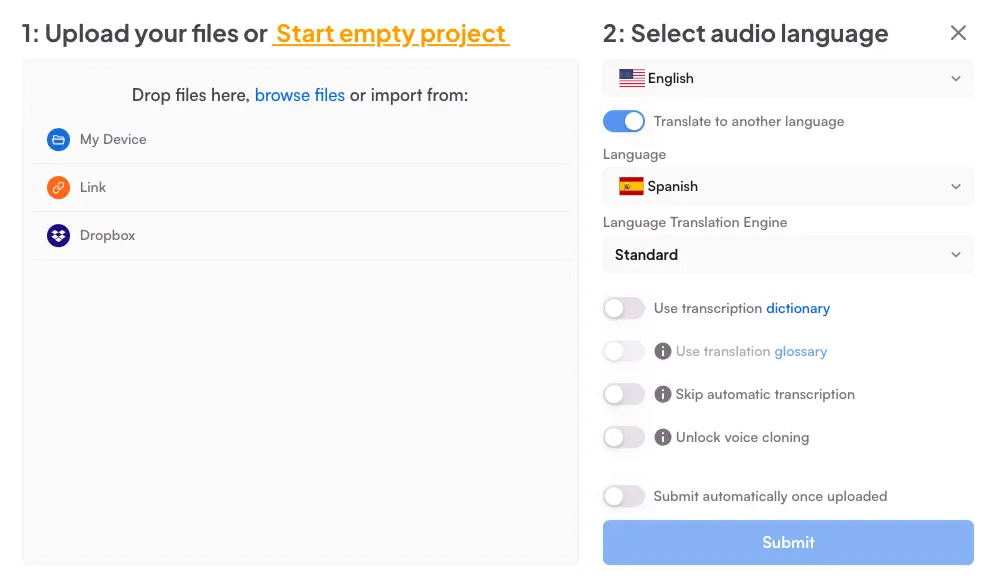
- Click "Submit". Maestra will automatically transcribe your file. Once processing is complete, click on the file to open it in the editor.
- Once in the editor, click the "AI Dubbing" button (marked in red). A pop-up will appear where you can browse and preview available voices in the target language. You can filter voices by gender, expression, and dialect to find the best match for different speakers in the video.
🚀 Tip: Here you can also unlock voice cloning by uploading a sample audio file and generating a voice clone that replicates the original speaker's tone and identity.
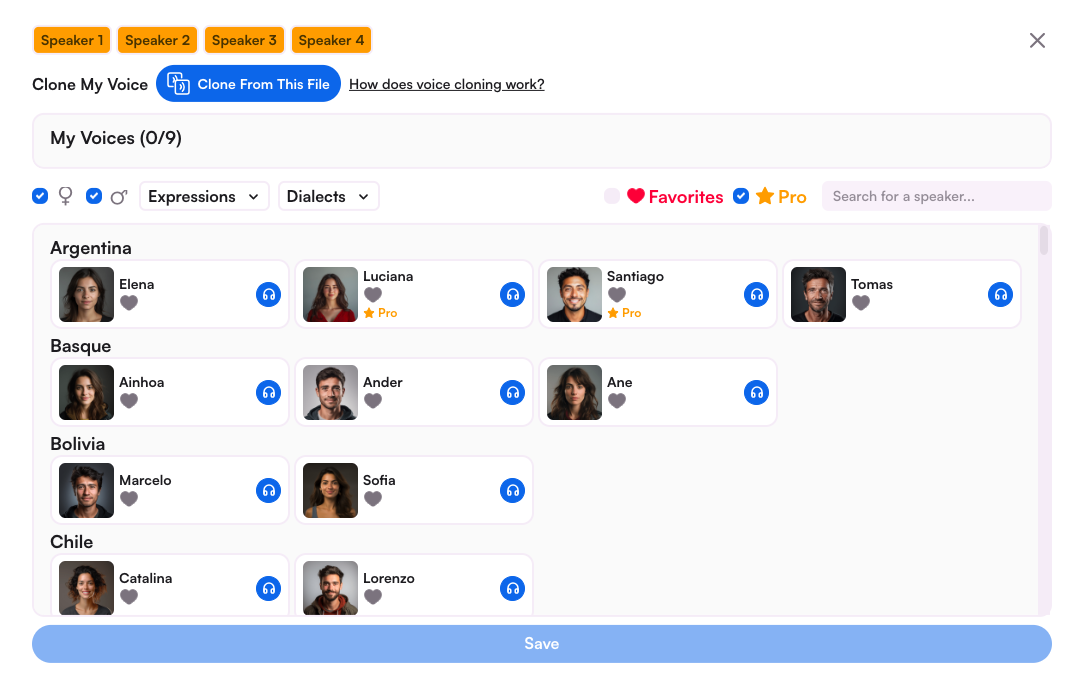
- Once you’ve selected your voices, click “Voiceover” to begin synthesis. The AI Dubbing button will turn green once the voiceover is generated. You can now watch the video with the dubbed audio.
- You'll see the transcript on the left side of the editor. Any changes you make here will be reflected in the voiceover instantly. You can also use the drag-and-drop slider at the bottom to fine-tune the timing.
🚀 Tip: Use the "AI Rewriting" feature to generate alternative sentence suggestions in the target language, perfect for adjusting tone or improving flow.
- To check translation accuracy, click "Check all" above the video player. This will review translated sentences along with an accuracy percentage, helping you quickly identify sections that may need refinement.
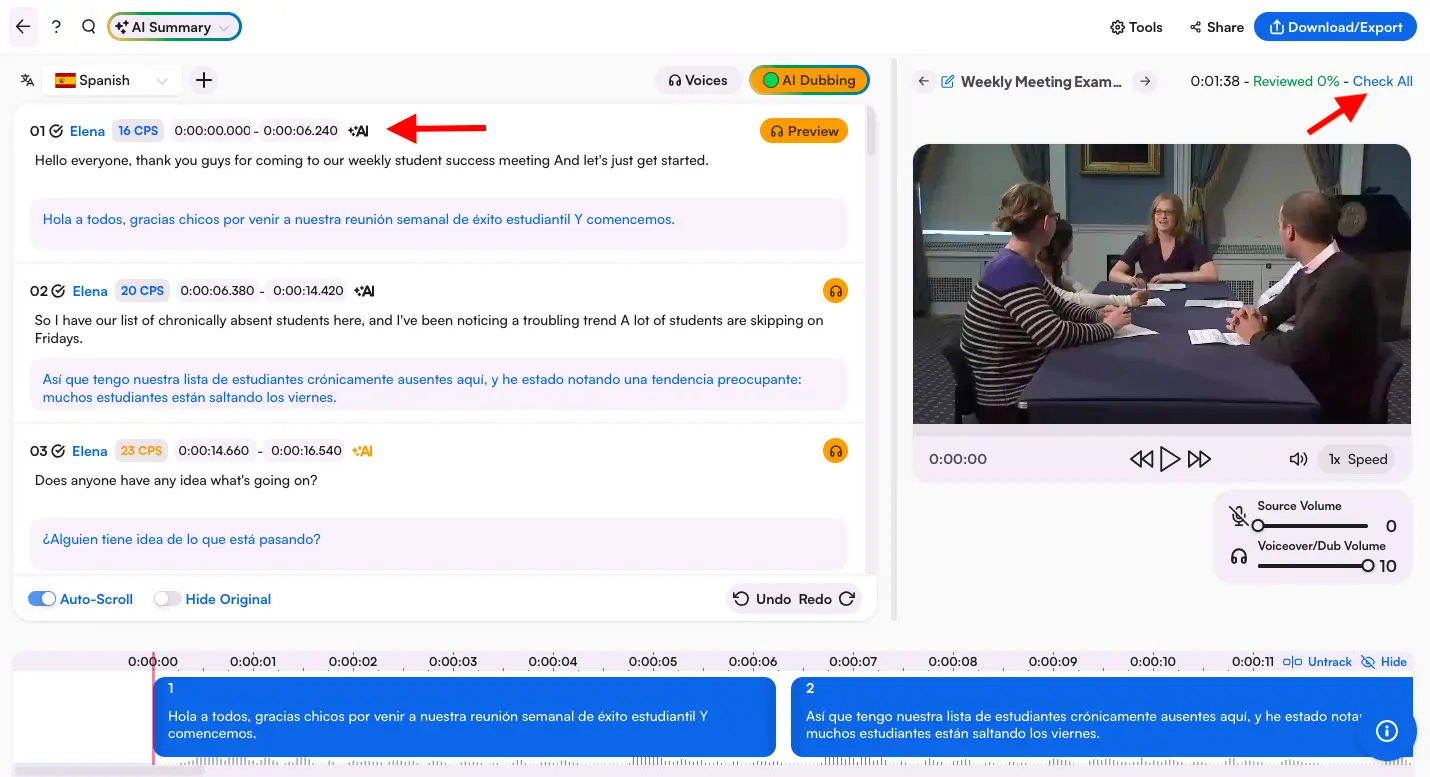
- To export the translated video, click "Export" in the top-right corner. Select the "Media" tab and make sure the "Export with voiceover" option is enabled. You can also choose to include subtitles and enable lip syncing for a more immersive final result.
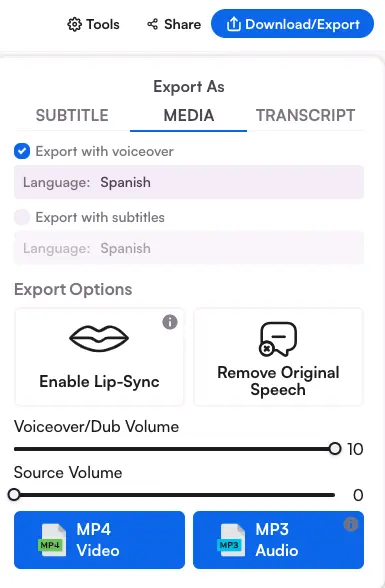
- To share your translated video, click "Share". You can invite collaborators to the project or embed the video directly into your website or blog using the built-in player; perfect for showcasing multilingual content anywhere.
🚀Tip: In the top-left corner of the editor, Maestra Pro users can access advanced AI features like summarization, chapter generation, keyword extraction, fact-checking, and more. These tools are ideal for improving SEO, reaching a wider audience, and increasing accessibility.
🚀 Tip: If your goal is to only translate audio from a video, simply export the project as an MP3 file.
Best Practices for Video Translation
Translating videos isn't just about converting words; it's about preserving meaning, tone, and clarity across different languages, cultures, and contexts. The following best practices for video voiceovers can dramatically improve the quality and impact of your translated content.
Use Clear Source Audio
Translation starts with transcription, so make sure your original audio is high-quality. Background noise, overlapping speakers, or unclear pronunciation can lead to transcription errors that result in poor translation accuracy.
Tip: Minimize ambient noise and ensure speakers don't talk over one another.
Use Consistent Terminology
Inconsistent use of terms can confuse viewers and reduce trust. If you're translating technical or branded content, create a glossary of preferred terms.
Tip: Look for an AI video translator that supports custom glossaries to ensure consistency.
Time Voiceovers and Subtitles Properly
Poor timing can disrupt viewer comprehension and reduce engagement. For subtitles, the text should appear and disappear in sync with the spoken words. For voiceovers, the translated audio should align with the original speaker’s pacing and emotional tone to preserve natural flow.
Tip: Use tools that offer automatic subtitle timing and AI-assisted voice syncing to streamline this step and avoid manual adjustments.

Maintain Visual Clarity
If you're adding subtitles, ensure they don't obscure important visual information, on-screen text, or graphics. The placement, font size, and color of subtitles should enhance readability without detracting from the video's visual message.
Tip: Choose clean subtitle styles that complement your video's layout, and opt for contrasting colors for maximum visibility across different screen sizes.
Optimize for Multilingual SEO
Once your video is translated, make sure it can be found by your target audience. This means optimizing your video's metadata (titles, descriptions, tags, and captions) in each target language to improve its visibility in search results on platforms like YouTube and Google. (For more information on how to localize your YouTube channel, you can check out this blog post.)
Tip: Use tools with built-in keyword extraction, like Maestra's AI video translator, to automatically identify relevant terms in each language.
Always Review the Results
Even with the most advanced AI tools, no translation is perfect out of the box. Always review the final output (whether it's voiceovers, subtitles, or transcripts) to catch errors, fine-tune phrasing, and ensure the message stays true to the original video.
Tip: Use editing tools within your video translator to make quick adjustments, or involve a native speaker for high-stakes content.
How to Overcome Common Video Translation Challenges
While video translation can significantly expand your content's reach, it's not without its hurdles. From emotional nuance to format compatibility, here are some of the most common challenges individuals and teams face, and how to solve them efficiently.
| Problem | Solution |
| Maintaining tone and emotion | Choose an online video translator with advanced voice cloning and emotional range, or use a hybrid approach with human refinement for critical content. |
| Format compatibility issues | Select a tool that exports common subtitle (.SRT, .VTT) and video formats (MP4) and offers platform integrations. |
| Costs vs. quality trade-offs | Utilize custom glossaries, speaker labeling, and quality scoring, as these features reduce the risk of errors and improve consistency. |
| Translating humor and idioms | Simplify or localize idioms where possible, and use human reviewers or cultural consultants when necessary. |
| Speaker overlap or fast dialogue | Use an AI tool with speaker diarization and adjustable subtitle timing to separate overlapping speech and sync fast dialogue accurately. |
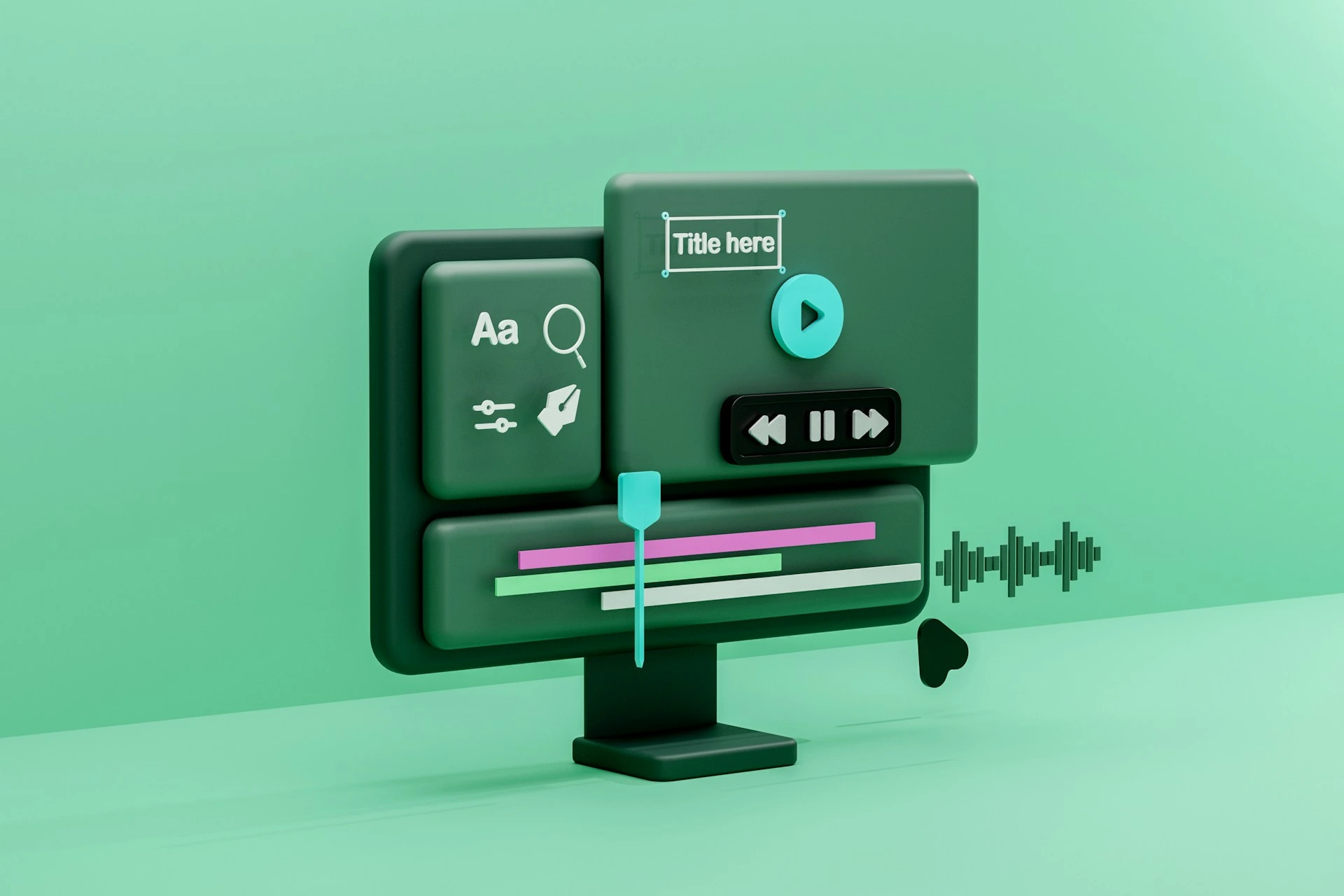
Conclusion
Video translation is no longer just a nice-to-have; it's a strategic advantage for anyone looking to reach global audiences, improve accessibility, and stay competitive in a content-driven world. With the right approach and the right platform, you can deliver meaningful messages in every language and meet your audience where they are, in the language they understand best.
Ready to get started? With Maestra you can:
✅ Translate videos into over 125 languages
✅ Dub videos with realistic AI voices
✅ Clone voices by uploading a sample to maintain speaker identity
✅ Sync lip movements with voiceovers using AI-powered lip syncing
✅ Subtitle videos automatically with accurate timing
✅ Export content in multiple formats (MP4, MP3, SRT, VTT, or plain text)
✅ Embed videos directly into your website or blog
✅ No credit card needed to start
Try Maestra's AI video translator now and make your content ready for the world.
Translate Videos into 125+ Languages
Frequently Asked Questions
Can I translate videos for free?
Yes, you can try Maestra's AI video translator for free. However, to unlock full functionality, you'll need to subscribe to a paid plan. Maestra offers a variety of pricing plans to fit different needs, from individual creators to enterprise teams.
What level of accuracy can I expect from AI-powered video translation?
AI video translation delivers strong accuracy for a wide range of use cases from YouTube videos to educational content. While it's not always 100% perfect, it's fast, reliable, and continuously improving. Maestra's AI video translator is known for its high-quality translation output, with support for speaker recognition, custom glossaries, and editing tools to fine-tune results when needed.
How long does it take to translate a video?
It depends on the length and size of your video, but Maestra's AI video translator typically completes the process in a few minutes. Shorter videos are translated almost instantly. Overall, it's much faster and efficient than manual translation.
How many languages does Maestra's AI video translator support?
Maestra's video translator supports over 125 languages, including English, Spanish, Chinese, Japanese, Arabic, Hindi, and more. Plus, with region-specific dialects like Latin American Spanish or Cantonese Chinese, you can deliver translations that truly feel local. Whether you're creating voiceovers or subtitles, Maestra’s AI video translation ensures high-quality, culturally relevant results.
Does Maestra support regional dialects?
Yes, Maestra supports a wide range of regional dialects to help your content sound authentic to specific audiences. From Cantonese Chinese and Mexican Spanish to Irish English and more, you can choose voices that reflect local tone and pronunciation. Feel free to explore the full collection of Maestra's 800+ AI voices.
Does Maestra offer support for multiple speakers in one video?
Yes, Maestra’s video translator supports multiple speakers within the same video. You can assign a distinct voice to each speaker during the video dubbing process, helping preserve clarity and conversational flow. This is especially useful for interviews or multi-character content.
What is voice cloning and how can I use it in my translations?
Voice cloning is a feature that allows you to replicate a speaker's voice and use it for translated speech in another language. By uploading a short voice sample, Maestra's AI can generate a cloned voice that maintains the speaker's tone across multiple languages. This is ideal for preserving consistency and authenticity in personal, branded, or character-driven content. For more information, you can check our voice cloning help guide.
Is lip syncing available for dubbed videos?
Yes, Maestra offers AI lip syncing to make video translation appear more natural and engaging. This feature adjusts the translated voiceover to better match the speaker's lip movements. This helps maintain the visual rhythm of your content, making translations feel less artificial.
Do I need advanced editing skills to use Maestra for video translation?
No, you don't need advanced editing skills to use Maestra. The platform is designed to be intuitive with a clean interface and easy-to-use editing tools. Whether you're a beginner or a pro, you can translate your videos in just a few clicks.
What formats can I export my translated video in?
You can export your translated video as an MP4 file with voiceover and subtitles included. You also have the option to export only the translated audio as an MP3, subtitles in formats like SRT or VTT, or the full transcript as a text file. This flexibility allows you to repurpose your content across different formats and platforms with ease.
Can I collaborate with others on video translation projects?
Yes, Maestra allows you to collaborate with team members by sharing projects directly within the platform. You can adjust permission levels to control who can view or edit your videos. This makes it easy to manage workflows across teams or clients.
Is Maestra's video translator suitable for large teams or organizations?
Yes, Maestra is built to support large teams or organizations. It offers tailored AI solutions for enterprises to align with their growing needs. See our Enterprise page to explore features and book a demo.
Can I translate videos with Maestra on mobile?
Yes, you can use Maestra on mobile to upload and manage video translation projects. However, for the best editing experience, especially when working with voiceovers or subtitles, we recommend using a desktop or laptop. Mobile is great for quick reviews and sharing, but detailed editing is more efficient on desktop.
How secure is my content on Maestra?
Maestra is hosted on Amazon Web Services (AWS), which adheres to globally recognized certifications such as ISO/IEC 27001:2013, 27017:2015, 27018:2019, and ISO/IEC 9001:2015. These standards ensure your data is stored and processed with top-tier security and compliance. Please visit our Security page for more information.
